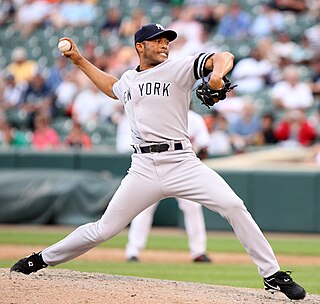This page is based on this
Wikipedia article Text is available under the
CC BY-SA 4.0 license; additional terms may apply.
Images, videos and audio are available under their respective licenses.
Baseball statistics play an important role in evaluating the progress of a player or team.
In baseball, an earned run is any run that was fully enabled by the offensive team's production in the face of competent play from the defensive team. Conversely, an unearned run is a run that would not have been scored without the aid of an error or a passed ball committed by the defense.
Sabermetrics is the empirical analysis of baseball, especially baseball statistics that measure in-game activity.
In baseball and softball, a pitcher's win–loss record indicates the number of wins and losses they have been credited with. For example, a 20–10 win–loss record would represent 20 wins and 10 losses.

In baseball, a save is credited to a pitcher who finishes a game for the winning team under certain prescribed circumstances, described below. The number of saves, or percentage of save opportunities successfully converted, is an oft-cited statistic of relief pitchers, particularly those in the closer role. It became an official Major League Baseball (MLB) statistic in 1969. Mariano Rivera is MLB's all-time leader in regular season saves with 652.
Runs created (RC) is a baseball statistic invented by Bill James to estimate the number of runs a hitter contributes to his team.
Pythagorean expectation is a sports analytics formula devised by Bill James to estimate the percentage of games a baseball team "should" have won based on the number of runs they scored and allowed. Comparing a team's actual and Pythagorean winning percentage can be used to make predictions and evaluate which teams are over-performing and under-performing. The name comes from the formula's resemblance to the Pythagorean theorem.
In baseball, value over replacement player is a statistic popularized by Keith Woolner that demonstrates how much a hitter or pitcher contributes to their team in comparison to a replacement-level player who is an average fielder at that position and a below average hitter. A replacement player performs at "replacement level," which is the level of performance an average team can expect when trying to replace a player at minimal cost, also known as "freely available talent."
In baseball, defense-independent pitching statistics (DIPS) measure a pitcher's effectiveness based only on statistics that do not involve fielders. These include home runs allowed, strikeouts, hit batters, walks, and, more recently, fly ball percentage, ground ball percentage, and line drive percentage. By focusing on these statistics, which the pitcher has almost total control over, and ignoring what happens once a ball is put in play, which the pitcher has little control over, DIPS can offer a clearer picture of the pitcher's true ability.

In baseball, the dead-ball era was the period between around 1900 and the emergence of Babe Ruth as a power hitter in 1919. That year, Ruth hit a then-league record 29 home runs, a spectacular feat at that time.
Batting Park Factor, also simply called Park Factor or BPF, is a baseball statistic that indicates the difference between runs scored in a team's home and road games. Most commonly used as a metric in the sabermetric community, it has found more general usage in recent years. It is helpful in assessing how much a specific ballpark contributes to the offensive production of a team or player.
Base runs (BsR) is a baseball statistic invented by sabermetrician David Smyth to estimate the number of runs a team "should have" scored given their component offensive statistics, as well as the number of runs a hitter or pitcher creates or allows. It measures essentially the same thing as Bill James' runs created, but as sabermetrician Tom M. Tango points out, base runs models the reality of the run-scoring process "significantly better than any other run estimator".
In baseball statistics, run average (RA) refers to measures of the rate at which runs are allowed or scored. For pitchers, the run average is the number of runs—earned or unearned—allowed per nine innings. It is calculated using this formula:

In baseball statistics, earned run average (ERA) is the mean of earned runs given up by a pitcher per nine innings pitched. It is determined by dividing the number of earned runs allowed by the number of innings pitched and multiplying by nine. Runs resulting from defensive errors are recorded as unearned runs and omitted from ERA calculations.
Wins Above Replacement or Wins Above Replacement Player, commonly abbreviated to WAR or WARP, is a non-standardized sabermetric baseball statistic developed to sum up "a player's total contributions to his team". A player's WAR value is claimed to be the number of additional wins his team has achieved above the number of expected team wins if that player were substituted with a replacement-level player: a player who may be added to the team for minimal cost and effort.
In baseball statistics, NERD is a quantitative measure of expected aesthetic value. NERD was originally created by Carson Cistulli and is part of his project of exploring the "art" of sabermetric research. The original NERD formula only took into account the pitcher's expected performance while the current model factors in the entire team's performance.
Pitch quantification is the attempt to describe the quality of a pitch using a single numeric value based on quantifiable aspects of an individual baseball pitch. There are two main kinds of pitch quantification. The first is outcome oriented. This means that the result of a given pitch is a component used to calculate the overall numeric value that describes the quality of the pitch. The other kind of pitch quantification does not consider the outcome of a pitch when calculating quality. Rather, it is batter independent. Its quality can be assessed without regard to what the batter does with the pitch.




